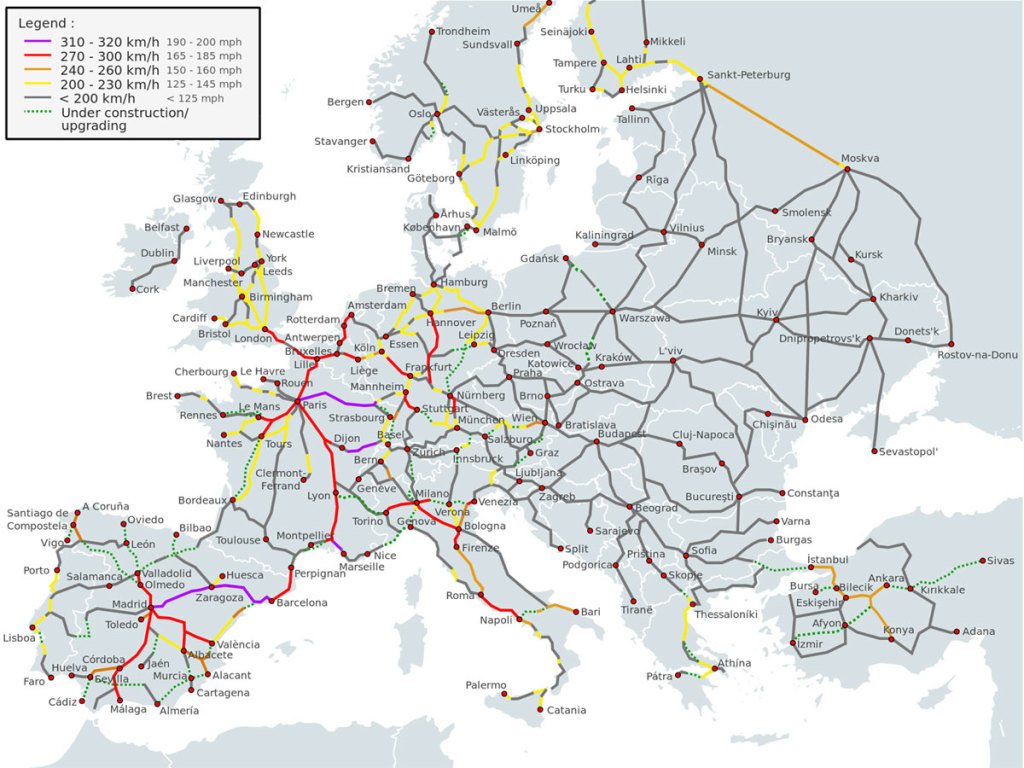High-speed trains speeding on high-speed lines (HSL) represent the 21st century’s rail transport, high-speed rail. At the beginning of a new era railroad was enlightened decisions of governments in countries such as Japan and France to invest in the construction of a suitable railway superstructure and in research and development of technologically new trains. The initial investment has paid off, in countries that have begun to build high-speed lines, the renaissance of long-distance rail transport has become reality. Railway gains back its lost position, which was taken by motorways and planes in the last century.
High-speed line – motorway for trains

High-speed line is characterized by minimum speed limit, which is 250 km/h (155 mph) on newly build tracks and 200 km/h (124 mph) on existing lines which have been upgraded. And also interchange crossing, so it does not conflict with other modes of transport. Japanese became pioneers of high-speed rail in the sixties of the 20th century. For Japanese high-speed lines they built a special track with standard gauge (1435 mm), compared with a narrow gauge used for ordinary Japanese trains (1064 mm).

In Europe, the French started building high-speed lines in standard gauge, high-speed trains can therefore use conventional lines and are not dependent only on the high-speed network. Today, all HSLs are built in standard gauge 1435 mm, regardless of gauge conventional track in a given country. One of the last states that began to build a high-speed rail network is China. Since 2002 it has gradually grown to the world’s longest high-speed rail network with nearly 12 000 km of HSLs (2014). All this is possible in a country where even in the 1980s you could see steam locomotives in the normal operation. According to the International Union of Railways (UIC) is to date 1.9.2014 in operation almost 23 000 km of high-speed lines (plus 13 000 km under construction) worldwide, of which, in Europe is in operation 7 400 km (plus 2 900 km under construction).
High-speed trains – planes on tracks

Most famous high speed trains are the Japanese Shinkansen, the French TGV (Train à Grande Vitesse), the German ICE (InterCity Express) or the Spanish trainset AVE. High-speed train (HST) should reach the maximum speed at least over 200 km/ h (124 mph). But most of these trains are able to achieve a speed of 300 km/ h or more. HST are either convectional riding on track with rails or unconventional “hovering” over the track using magnetic levitation. Maglev train holds the world record with a speed of 603 km/h (375 mph) from April 2015. But because of high investment costs Maglev trains are used rarely. Fastest convectional train using rail tracks is the French train TGV which reached 574.8 km/h (357.2 mph) in 2007.
High-speed trains operate in almost all countries of Western Europe (France, Spain, Germany, Italy, UK, Benelux, Switzerland, Austria, Sweden, Finland, …) but also in Russia, Turkey or in Asia (Japan, China, Taiwan, South Korea). Closely to opening are HSLs in Morocco and Saudi Arabia.
Future of high-speed rail
EU has set up plans for the common transport policy in The White Paper on Transport from 2011. Main goals for railway are following. By 2050, complete a European high-speed rail network. Triple the length of the existing high-speed rail network by 2030 and maintain a dense railway network in all Member States. By 2050 the majority of medium-distance passenger transport should go by rail.

High-speed rail in the Czech Republic
In the Czech Republic do not exist any high-speed lines. On main national rail corridors maximum speed is 160 km/h (99 mph). There are only plans for high-speed rail in the Czech Republic. The Ministry of Transport plans high-speed rail network consisting of newly built lines with max. speed 350 km/h (217 mph) and upgraded lines for 200 km/h. The network is called “Rychla spojeni” (Fast connections). Core of this network is domestic line HSL1 (RS1) Prague-Brno-Ostrava. To fulfil goals of EU defined by the White Paper on Transport, Czech Rep. needs to set own national conception “development of high-speed rail” including of schedule and financial framework. Nice example is from Spain. They had introduced PEIT (Strategic Infrastructure Plan of the Ministry of Development, 2005-2020) with goals and financial framework incl. EU co-financing. Despite the Czech rep. has opportunities to use EU funds for building of transport infrastructure, there are not successful to use all subsidies.
Advantages and disadvantages of high-speed rail

The indisputable advantages of high-speed railways include shorter traveling time (within a distance of 600 km competes aircraft), minimal emissions, low accident rate, less land needs compared to the construction of highways and a better opportunity to use travel time to car traffic. For disadvantages can be considered higher acquisition costs of special train-sets and the emergence of a new line barriers in the landscape. Noise pollution which is unjustly opponents emphasized, has not a permanent character as by motorways. Average price per kilometre of the construction of the new HSL (top speed of 300 km/ h) is similar to motorway, upgrading existing track on HSL (200 km/ h) costs are about 40% lower than for motorway construction.